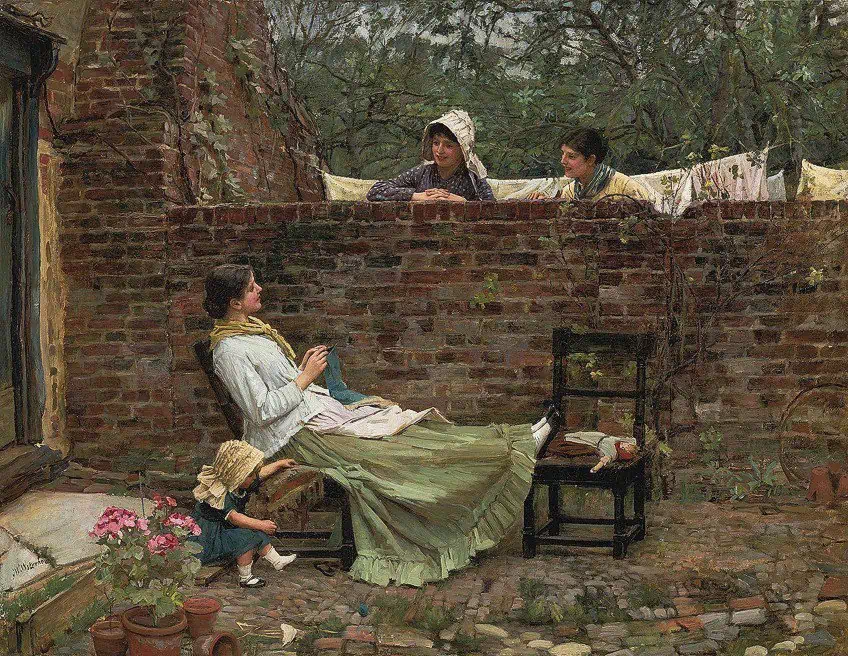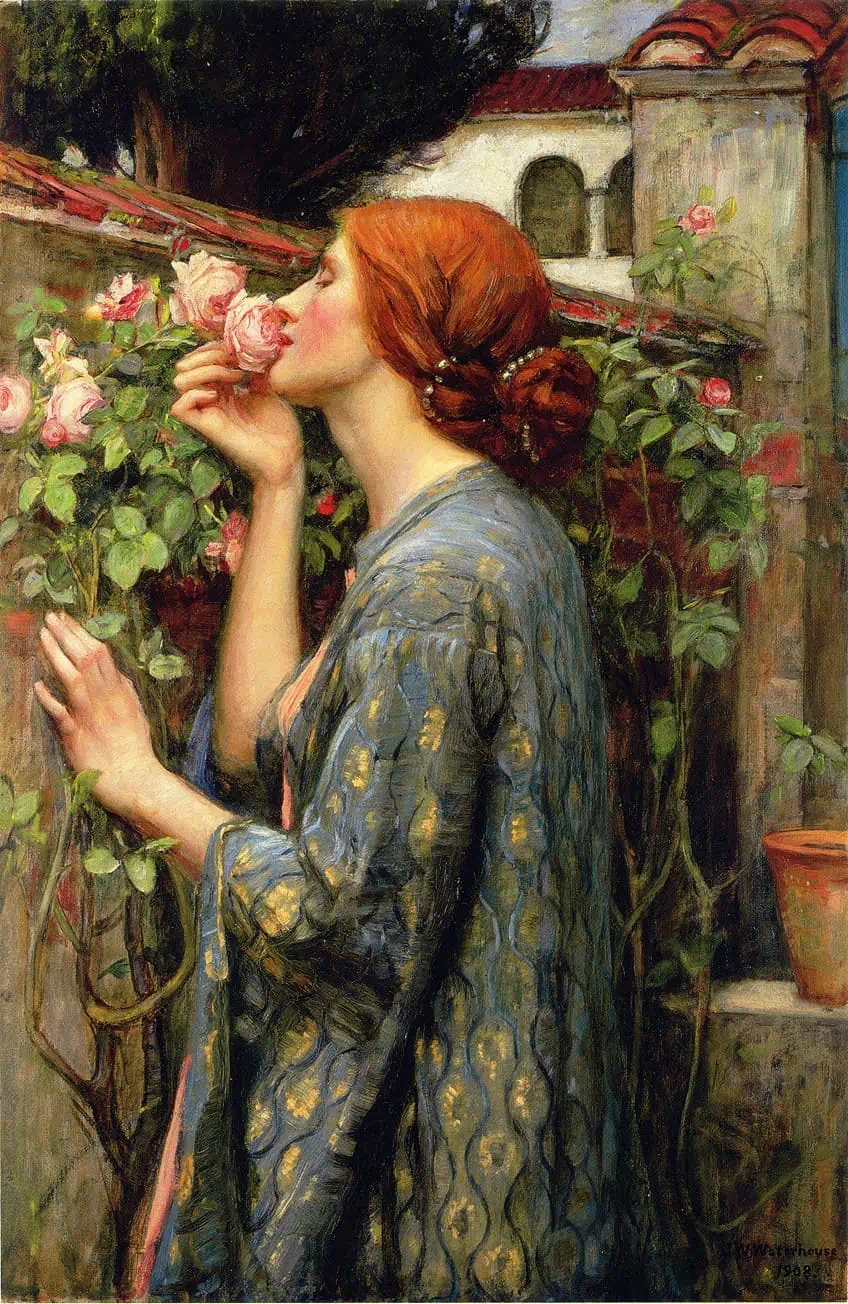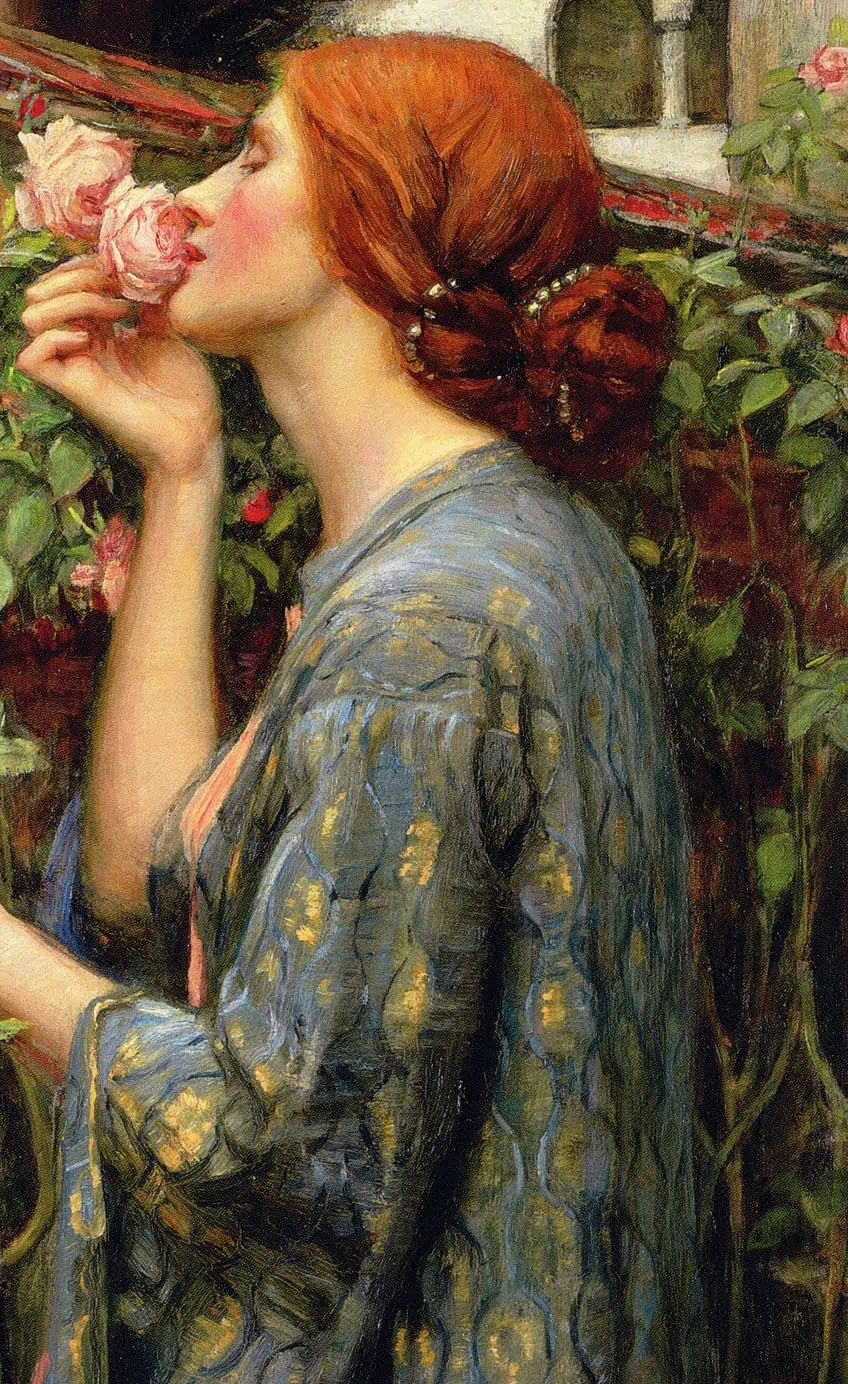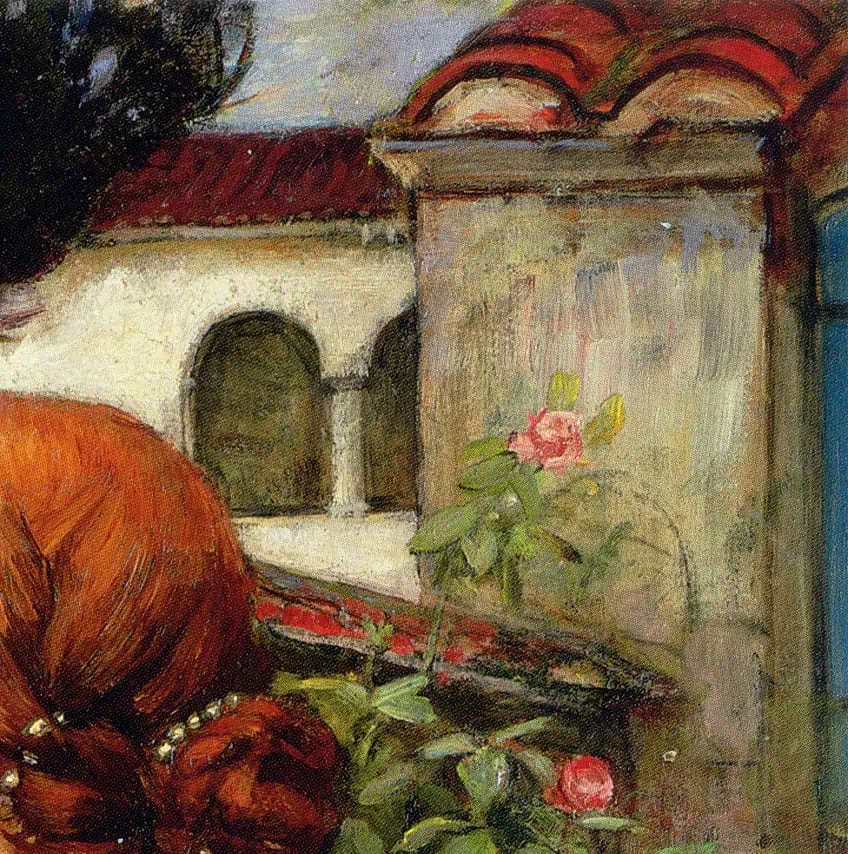“The Soul of the Rose” by John William Waterhouse – A Glimpse
The Soul of the Rose by John William Waterhouse differs from many of the artist’s other works in that it is not taken from an old or popular love story. Instead, the inspiration was taken from a poem, yet, various sources differ in opinion as to what poem inspired it. Some state that it was influenced by a poem by Alfred Lord Tennyson called Maud (1854), while others say it was based on the poetry of Chaucer. Whatever its source of inspiration, it was produced at the height of the artist’s creative abilities, is infused with sensuality, and is worthy of further discussion below!
Contents
Understanding The Soul of the Rose by John William Waterhouse
| Artist Name | John William Waterhouse (1849 – 1917) |
| Date Completed | 1908 |
| Medium | Oil on canvas |
| Dimensions (cm) | 91 x 61 |
| Location | Private collection |
While some scholars believe that this famous artwork was inspired by the poetry of Lord Tennyson, others have named Chaucer’s Romaunt of the Rose as the literary source of inspiration. Yet, this poem was based on an even older poem from the 13th century called Roman de la Rose by Guillaume de Lorris. In the poem, the narrator is led to a rose that symbolizes ideal love while on a journey with the god of love.
Waterhouse’s teacher, Sir Edward-Burne Jones, had already produced an earlier work based on this poem which was designed for a tapestry.
Titled The Heart of the Rose (1889), Jones portrayed the rose as a young girl who became the object of love for the poet. Waterhouse’s version is not so easily understood and perhaps only connected in relation to its sense of medievalism. Before we find out more about the meaning of this beautifully sensual painting, let us first introduce you to its creator, the famed English artist, John William Waterhouse.
A Brief Introduction to John William Waterhouse
| Artist Name | John William Waterhouse |
| Nationality | English |
| Date of Birth | 6 April 1849 |
| Date of Death | 10 February 1917 |
| Place of Birth | Rome, Italy |
The English artist John William Waterhouse adopted the artistic traditions of the Pre-Raphaelites Dante Gabriel Rossetti and John Everett Millais in his own works. He, like these aforementioned painters, portrayed elegant women in roles inspired by mythology and literature. Waterhouse was born to a family of English painters in Rome on the 6th of April, 1849, and five years later, the family moved back to London. As an aspiring young artist, he decided to enroll at the Royal Academy of Art, and while he first began studying sculpture, by 1874 he had committed himself fully to pursuing painting as his medium of choice.
The oil studies he produced during his plein-air painting journeys in Italy and the English countryside enhanced his artwork in the late 1880s.
He started to exhibit portrait paintings at this time as well, as commissions rose and his popularity grew. Waterhouse was born at an age when the Industrial Revolution was fully underway and unemployment was rampant in England’s poorest neighborhoods. The clear and precise lines of the previous Neoclassical era were being rejected by a large portion of the art world. They began to create sculptures and paintings that took the viewer into another realm, far removed from the reality of daily life. It was at this time that he also began to be influenced by the works of the Pre-Raphaelite Brotherhood.

This group of painters formed in response to the Royal Academy’s glorification of Raphael as the ultimate painter of all time. They additionally resented what they saw as the superficiality of genre painting, which was very fashionable in the mid-1800s. It is regarded by some as being among the first avant-garde art movements, yet they did not receive this recognition due to their devotion to historical painting and traditional mimicry of nature. The movement was primarily motivated by Romanticism, though they were subsequently divided over the Idealism vs. Realism debate.
His depictions of classical subjects demonstrate a blending of Romantic and Neoclassical themes, which would be refined by other artists during the remainder of the 19th century.
His appreciation of natural settings, as well as gorgeous women, made his art truly distinctive and immensely popular with his customers. Waterhouse was not alone in his devotion to the feminine figure during the Pre-Raphaelite period. Several of the models would even appear in other Pre-Raphaelite artists’ works, and they developed a look that was ideally suited to this movement, which was typically tall and thin brunettes with exceptionally pale complexions and rosy cheeks.

He lived a very tranquil life, free of any major upsets or dramas, preferring to produce beautiful pieces that expressed stories of love and sadness. While his paintings were no longer deemed fashionable in the early 20th century, he proceeded to exhibit his works all throughout his life.
Although he suffered from illness for the last 10 years of his life, he continued to paint until he passed away on the 10th of February, 1917.
An Analysis of The Soul of the Rose by John William Waterhouse
Waterhouse’s captivating lady leans in to take in the fragrance of a rose. She breathes it in deeply as if the mere fragrance will reveal some hidden secret from within. While this woman may still be the focus of another’s desire, viewers are also urged to muse about her psyche and what she may be experiencing. She is an active participant in this narrative, not merely a passive symbol of someone else’s affection. The artwork’s location seems to be a walled-in Tuscan garden, reminiscent of works by painters from the 14th century like Fra Angelico.
The artwork’s overarching theme is ideally suited to the dichotomy of the closed-off garden – something that is plentiful yet contained.
Waterhouse’s initial sketch for the painting displays little resemblance to the final image, which depicts a dark-haired female, plainly dressed, stretching up to smell a rose. The artist changed his sketch into something genuinely beautiful in the execution of the oil painting; the subject’s red-colored hair, brocade fabric gown, and relative maturity (she is portrayed as a young woman in the painting, not a girl like in the initial study), identify her more with the tradition of courtly love spoken about in the artwork’s literary influences.

This painting is one of a series of artworks from the early 1900s that feature solitary red or dark-haired women. These subjects, though, are difficult to identify due to a lack of sufficient documentation. The young woman featured in this particular painting could be Miss Muriel Foster, who posed for the artist on several occasions. His fundamental concept, displayed in a number of the artist’s other works, associated women with nature by means of the idea of regeneration. While this concept was already well-established, the way he approached it was new and his technique evolved significantly over the years.
The artwork’s romantic sensibility and the impression of melancholy in the woman’s face enable it to represent Romantic-era stylistic ideas and beliefs.
Composition
Waterhouse fulfills the ideals of his day in this painting through the creation of an atmosphere of romance. Although there is just one figure in the work of art, it is apparent from her expression that the fragrance of the flower reminds her of an occasion or an individual who is not in the work of art. Her closed eyes along with a tilted face away from the observer imply that she is deeply absorbed in her own thoughts.
The female figure occupies the majority of the artwork, as it does in many of Waterhouse’s other works.

The background is unimportant in this painting; unlike in a few of his other paintings, there is no additional narrative to be found in this background. Instead, the use of towering walls and vertical and horizontal lines produces the impression that the figure is both literally and psychologically confined. As the woman smells the flower, Waterhouse brings his viewers’ attention to the woman’s face and her feelings of desire.
The delicateness of her form, particularly her hand, contrasts with the power of the walls around her, emphasizing the notion of suppressed femininity even further.
Themes
The artist’s female subjects were usually infused with a powerful feeling of sensuality, whether it be in the form of their bodies or merely a delicate expression. The artist depicts the woman in the painting without any evident sexiness, yet her stance against the wall and her dainty hand convey a subtle sensuality. Many of the artist’s works depict the social standing of women within society at that period of time. For women, England in the Victorian era was a place where, for the very first time, they could cast their votes in elections and exercise other rights that they were once refused.
Many of the women he portrays seem confined, and he appears to be drawn to the concept of a powerful yet constrained female.

This might have been his observation of women with significant public reputations throughout his lifetime. This artwork is no exception, as the woman is presented against a brick wall, her enjoyment being found in nature and her memories of a past love. During the same year that Waterhouse created this work, he also produced several others involving roses and women.
Color and Lighting
Waterhouse used a warm color palette in this piece. Earthy oranges, pinks, and browns are combined to create a summery ambiance. The cool blue utilized in her beautiful dress contrasts with these natural tones, which assist in enhancing the color of her cheeks.

The deep blue, interwoven with gold, represents fortune and success. He employs natural lighting in this image, which adds a sense of realism and makes the setting more convincing because the woman is standing outside. The light from above offers purity to a rather sensual image by illuminating the woman’s hair and complexion.
Brushstrokes
Waterhouse employs a free brush stroke in this and all of his other works, yet still manages to convey details and a sense of realism. The typically strong brush strokes are subdued by exquisite details on the female figure’s face and garments, while the background is less defined, offering dimension and depth to the artwork.
Waterhouse’s painting is ageless because of his sensual, natural mastery of his medium, as well as the luminosity of his beautiful women.

Inspired by various poems, The Soul of the Rose by John William Waterhouse itself is a kind of visual poetry. With its subtle sensuality, it pulls the viewer into the woman’s world as she dreams of love past while smelling the fragrance of a rose. As with many of the artist’s works, she represents a powerful and beautiful woman confined within a space, this time an enclosed garden. Stunningly rendered, the viewer’s attention is focused on various elegant features such as her clothing and her delicate hands. While the artist’s style eventually fell from favor, his works, such as this one, are highly revered today.
Frequently Asked Questions
What Style of Art Did John William Waterhouse Make?
Waterhouse’s paintings often included subjects from ancient mythology, medieval stories, and literary works, but he was most known for his depictions of beautiful ladies in lush settings. His work was connected to the Pre-Raphaelite Brotherhood, which was a group of 19th-century painters who wanted to revive the colorful and detailed painting style that existed before the High Renaissance. His paintings are known for their high degree of detail, vibrant color palette, and emphasis on symbolic and romantic narratives.
What Is The Soul of the Rose by John William Waterhouse About?
The focal subject of this famous painting by Waterhouse is an elegant young woman enclosed in a garden and surrounded by luscious pink roses. She holds onto a solitary rose and seems to be examining it with a lot of emotion and introspection. From her posture and facial expression, one can see that she is experiencing melancholy as she thinks of a love that once was. While the painting may portray a rather innocent moment, it is also imbued with subtle sensuality.
Jordan Anthony is a Cape Town-based film photographer, curator, and arts writer. She holds a Bachelor of Art in Fine Arts from the University of the Witwatersrand, Johannesburg, where she explored themes like healing, identity, dreams, and intuitive creation in her Contemporary art practice. Jordan has collaborated with various local art institutions, including the KZNSA Gallery in Durban, the Turbine Art Fair, and the Wits Art Museum. Her photography focuses on abstract color manipulations, portraiture, candid shots, and urban landscapes. She’s intrigued by philosophy, memory, and esotericism, drawing inspiration from Surrealism, Fluxus, and ancient civilizations, as well as childhood influences and found objects. Jordan is working for artfilemagazine since 2022 and writes blog posts about art history and photography.
Learn more about Jordan Anthony and about us.
Cite this Article
Jordan, Anthony, ““The Soul of the Rose” by John William Waterhouse – A Glimpse.” artfilemagazine – Your Online Art Source. November 8, 2023. URL: https://artfilemagazine.com/the-soul-of-the-rose-by-john-william-waterhouse/
Anthony, J. (2023, 8 November). “The Soul of the Rose” by John William Waterhouse – A Glimpse. artfilemagazine – Your Online Art Source. https://artfilemagazine.com/the-soul-of-the-rose-by-john-william-waterhouse/
Anthony, Jordan. ““The Soul of the Rose” by John William Waterhouse – A Glimpse.” artfilemagazine – Your Online Art Source, November 8, 2023. https://artfilemagazine.com/the-soul-of-the-rose-by-john-william-waterhouse/.



